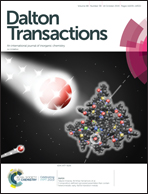Synthesis and electropolymerization of N-heterocyclic carbene complexes of Pd(ii) and Pt(ii) from an emissive imidazolium salt with a terthiophene backbone†
Abstract
The synthesis of an emissive terthiophene-based imidazolium iodide: 1,3-dimethyl-4,6-di(thiophen-2-yl)-thienoimidazol-3-ium iodide (4), the corresponding N-heterocyclic carbene (NHC) preligand, and Pd and Pt–NHC complexes (5a, 5b) are reported. A related Pd–NHC complex (8) with a mono-thiophene backbone has also been synthesized. The solid-state structures were determined by single crystal X-ray diffraction studies. Compounds 4, 5a and 5b were characterized by absorption/emission spectroscopy and an emission-quench phenomenon of 5a was observed. The Pd complexes 5a and 8 were shown to catalyze Heck type C–C bond forming reactions. The compounds with terthiophene backbones (4, 5a, 5b) were electropolymerized onto indium tin oxide (ITO)-coated glass electrodes to yield thin films of conducting metallopolymers (CMPs) (P1–3). UV-vis-NIR spectroelectrochemistry data of P1–3 showed reversible color changes upon oxidation due to the generation of charge carrier species along the polythiophene backbones.



 Please wait while we load your content...
Please wait while we load your content...
